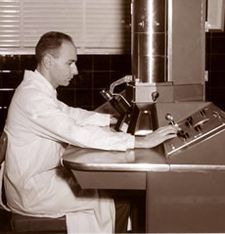Humberto Fernández-Morán facts for kids
Quick facts for kids
Humberto Fernández-Morán Villalobos
|
|
|---|---|

Fernández-Morán Villalobos on the electron microscope at IVIC in the 1950s
|
|
| Born | 18 February 1924 |
| Died | 17 March 1999 (aged 75) |
| Alma mater | |
| Known for | Diamond knife Founder of IVIC Cryoultramicrotomy Electron cryomicroscopy |
| Awards | Order of the Polar Star, John Scott Award |
| Scientific career | |
| Fields | Medicine |
| Institutions | Central University of Venezuela (UCV), NASA, MIT, University of Chicago, University of Stockholm |
Humberto Fernández-Morán Villalobos (born February 18, 1924 – died March 17, 1999) was a brilliant scientist from Maracaibo, Venezuela. He is famous for inventing the diamond knife, a super sharp scalpel. He also made big improvements to electron microscopes. He did this by using special magnets cooled to very low temperatures. He made many other important scientific discoveries too!
Contents
A Scientist's Journey
Humberto Fernández-Morán started a special science center in Venezuela. It was called the Venezuelan Institute for Neurological and Brain Studies. This center later became the Venezuelan Institute of Scientific Research (IVIC).
He studied medicine at the University of Munich in Germany. He graduated with top honors in 1944. He helped make electron microscopes much better. He was also the first person to use a method called cryo-ultramicrotomy. This means cutting very thin slices of frozen samples.
The Diamond Knife and Ultramicrotome
After flying over Angel Falls in Venezuela, he got an idea. He thought about how the water flows smoothly. This inspired him to combine his diamond knife with a machine called an ultramicrotome.
An ultramicrotome is a tool that cuts incredibly thin slices. It uses the diamond knife to cut samples for electron microscopes. These slices are so thin, they are just a few atoms thick! This invention helped scientists see tiny details inside cells.
Cool Science: Electron Cryomicroscopy
Fernández-Morán also helped develop electron cryomicroscopy. This is a special way to use electron microscopes. It uses superconductive magnets cooled with liquid helium. This helps scientists get the clearest pictures possible of tiny things.
Work with NASA
In 1957, he helped supervise Venezuela's first nuclear reactor. It was called the RV-1 nuclear reactor. This was one of the first in all of Latin America.
Later, he worked with NASA on the Apollo Project. This was the project that sent humans to the Moon! He also taught at many famous universities. These included MIT, the University of Chicago, and the University of Stockholm.
In 1986, he gave a collection of his important papers to the National Library of Medicine.
Personal Life
Humberto Fernández-Morán's wife, Anna, was from Sweden. They had two daughters together, named Brigida Elena and Verónica.
Dr. Fernández-Morán's body was cremated. His ashes now rest in the Cemetery The Square Luxburg-Carolath in his hometown of Maracaibo.
Key Inventions
- Diamond knife
- Ultra microtome
Awards and Recognition
- In 1967, he received the John Scott Award. This was for his invention of the diamond scalpel.
- He was made a Knight of the Order of the Polar Star.
- He also received the Claude Bernard Medal from the University of Montreal.
- He won the Cambridge annual Medical Prize.
See also
 In Spanish: Humberto Fernández-Morán para niños
In Spanish: Humberto Fernández-Morán para niños
- List of Venezuelans

